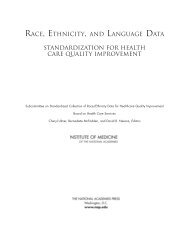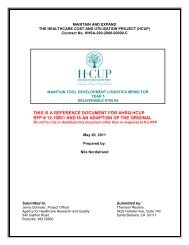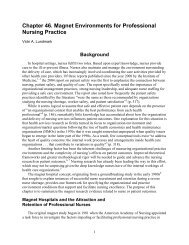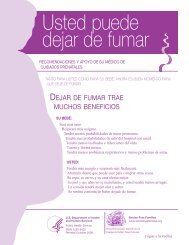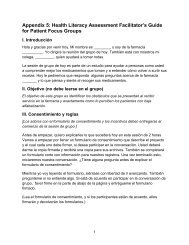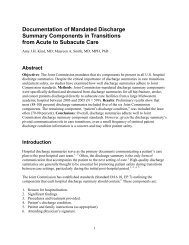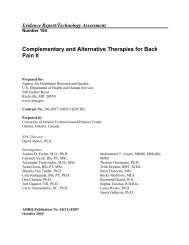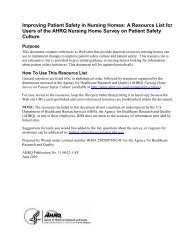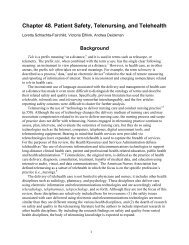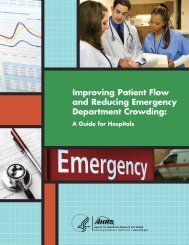Chapter 11. Reducing Functional Decline in Hospitalized Elderly
Chapter 11. Reducing Functional Decline in Hospitalized Elderly
Chapter 11. Reducing Functional Decline in Hospitalized Elderly
Create successful ePaper yourself
Turn your PDF publications into a flip-book with our unique Google optimized e-Paper software.
Patient Safety and Quality: An Evidence-Based Handbook for Nurses<br />
functional decl<strong>in</strong>e <strong>in</strong> the elderly dur<strong>in</strong>g hospitalization <strong>in</strong>cluded hav<strong>in</strong>g two or more<br />
comorbidities, tak<strong>in</strong>g five or more prescription medications, and hav<strong>in</strong>g had a hospitalization or<br />
emergency room visit <strong>in</strong> the previous 12 months. 25<br />
Associations between functional status and other risk factors such as cognitive status must<br />
also be considered. Hospital-related complications or <strong>in</strong>adequate hospital care have been l<strong>in</strong>ked<br />
to the development of delirium <strong>in</strong> the hospitalized elderly. 26 Impairment <strong>in</strong> cognitive status was<br />
found to be associated with changes <strong>in</strong> functional status <strong>in</strong> the hospitalized elderly. A study of<br />
2,557 patients from two teach<strong>in</strong>g hospitals exam<strong>in</strong>ed the association between level of impaired<br />
performance on a cognitive status screen and ma<strong>in</strong>tenance and recovery of function<strong>in</strong>g from<br />
admission through 90 days after discharge. Performance on a brief cognitive screen on admission<br />
was strongly related to subsequent change <strong>in</strong> function. Among patients who needed help<br />
perform<strong>in</strong>g one or more ADLs at the time of admission, 23 percent of patients with moderate to<br />
severely impaired cognitive performance, 49 percent of patients with mildly impaired cognitive<br />
performance, and 67 percent of patients with little or no impairment <strong>in</strong> cognitive performance<br />
recovered the ability to <strong>in</strong>dependently execute an additional ADL by discharge (P < 0.001). 22<br />
Additional studies identified that prolonged recovery and cont<strong>in</strong>ued ADL limitations occurred<br />
after hospitalization. In follow<strong>in</strong>g 1,279 patients age 70 years and older after hospital discharge,<br />
a study found that 59 percent reported no change <strong>in</strong> ADL status, 10 percent reported<br />
improvement, and 39 percent reported decl<strong>in</strong>ed ADL status at discharge when compared to<br />
preadmission status. At 3 months after discharge, 40 percent reported a new ADL or IADL<br />
disability compared with preadmission, reflect<strong>in</strong>g the potential for cont<strong>in</strong>ued functional decl<strong>in</strong>e<br />
after hospitalization for acute illness. 27<br />
Yet, the loss of functional <strong>in</strong>dependence is not an <strong>in</strong>evitable consequence of hospitalization<br />
for the elderly. 28, 29 Evidence exists that targeted <strong>in</strong>terventions can impact the degree of<br />
functional <strong>in</strong>dependence for hospitalized elders. 30<br />
Research Evidence<br />
Targeted measures that have proven beneficial <strong>in</strong> mitigat<strong>in</strong>g functional decl<strong>in</strong>e dur<strong>in</strong>g<br />
hospitalization have <strong>in</strong>cluded comprehensive geriatric assessments to identify patients at risk,<br />
structured geriatric care models, dedicated hospital units for acute care of the elderly, and the use<br />
of specific resources to enhance care for the hospitalized elder.<br />
Comprehensive Geriatric Assessment<br />
Comprehensive geriatric assessment (CGA) is used to create a plan of care for hospitalized<br />
elders. A specific goal of the CGA is early identification of elder care needs <strong>in</strong> order to provide<br />
<strong>in</strong>terventions to m<strong>in</strong>imize high-risk events such as falls or the onset of delirium. 31<br />
A CGA should <strong>in</strong>clude assessment of ADL and IADL performance as well as assessment of<br />
cognition, vision and hear<strong>in</strong>g, social support, and psychological well-be<strong>in</strong>g. 19 A number of<br />
geriatric assessment tools can be used to make <strong>in</strong>itial and ongo<strong>in</strong>g evaluations of hospitalized<br />
elders. Commonly used tools <strong>in</strong>clude the Katz Index of Independence <strong>in</strong> Activities of Daily<br />
Liv<strong>in</strong>g, 32 the Lawton Instrumental Activities of Daily Liv<strong>in</strong>g Scale, 33 and the Hospital Admission<br />
Risk Profile (HARP), among others (see Table 2).<br />
4



